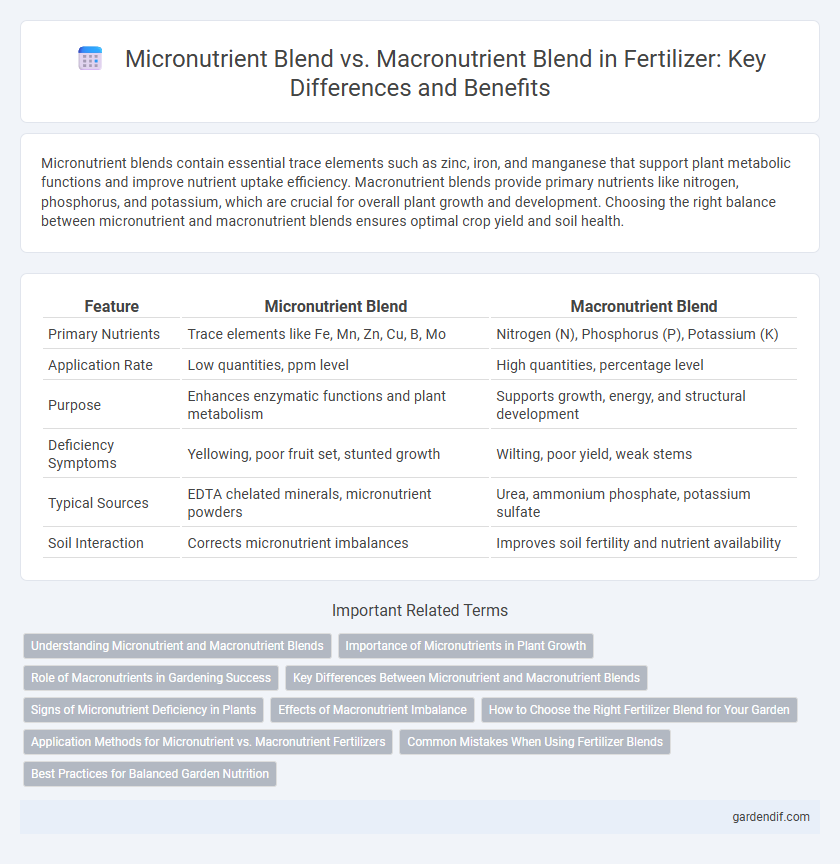
Micronutrient blend vs Macronutrient blend Illustration
Micronutrient blends contain essential trace elements such as zinc, iron, and manganese that support plant metabolic functions and improve nutrient uptake efficiency. Macronutrient blends provide primary nutrients like nitrogen, phosphorus, and potassium, which are crucial for overall plant growth and development. Choosing the right balance between micronutrient and macronutrient blends ensures optimal crop yield and soil health.
Table of Comparison
| Feature | Micronutrient Blend | Macronutrient Blend |
|---|---|---|
| Primary Nutrients | Trace elements like Fe, Mn, Zn, Cu, B, Mo | Nitrogen (N), Phosphorus (P), Potassium (K) |
| Application Rate | Low quantities, ppm level | High quantities, percentage level |
| Purpose | Enhances enzymatic functions and plant metabolism | Supports growth, energy, and structural development |
| Deficiency Symptoms | Yellowing, poor fruit set, stunted growth | Wilting, poor yield, weak stems |
| Typical Sources | EDTA chelated minerals, micronutrient powders | Urea, ammonium phosphate, potassium sulfate |
| Soil Interaction | Corrects micronutrient imbalances | Improves soil fertility and nutrient availability |
Understanding Micronutrient and Macronutrient Blends
Micronutrient blends consist of essential trace elements like iron, manganese, zinc, copper, and boron, which support enzymatic functions and improve plant health at cellular levels. Macronutrient blends provide primary nutrients such as nitrogen, phosphorus, and potassium required in larger quantities for growth, energy production, and root development. Understanding the balance between micronutrient and macronutrient blends ensures optimal nutrient uptake, enhances crop yield, and prevents deficiencies that can impair plant growth.
Importance of Micronutrients in Plant Growth
Micronutrient blends, containing essential elements like zinc, iron, and manganese, play a critical role in enzyme activation, chlorophyll synthesis, and overall plant metabolism, which macronutrient blends such as nitrogen, phosphorus, and potassium cannot fulfill alone. Deficiencies in micronutrients often lead to stunted growth, reduced yield, and compromised plant health, highlighting their importance despite being required in smaller quantities. Integrating both micronutrient and macronutrient blends ensures balanced nutrient availability, optimizing plant development and crop productivity.
Role of Macronutrients in Gardening Success
Macronutrients like nitrogen, phosphorus, and potassium play a crucial role in gardening success by supporting essential plant functions such as growth, root development, and flowering. These elements are required in larger quantities compared to micronutrients, which are needed in trace amounts for specific enzymatic and physiological processes. Proper macronutrient balance ensures optimal photosynthesis, nutrient uptake, and overall plant health, directly impacting crop yield and quality.
Key Differences Between Micronutrient and Macronutrient Blends
Micronutrient blends contain essential trace elements such as iron, zinc, manganese, copper, molybdenum, and boron, which support plant physiological functions and enzyme activation, whereas macronutrient blends primarily supply nitrogen, phosphorus, and potassium that drive overall plant growth and biomass production. The concentration of nutrients in micronutrient blends is significantly lower, typically measured in parts per million, compared to macronutrient blends that are measured in percentage terms to meet plants' higher nutrient demand. Micronutrient blends enhance crop quality and stress resistance, while macronutrient blends focus on increasing crop yield and vigor.
Signs of Micronutrient Deficiency in Plants
Micronutrient deficiency in plants often manifests through specific symptoms such as chlorosis, interveinal yellowing, and stunted growth due to the lack of essential elements like iron, zinc, and manganese. Unlike macronutrient blends that supply high-quantity nutrients such as nitrogen, phosphorus, and potassium critical for overall plant growth, micronutrient blends address trace element shortages that affect enzymatic functions and photosynthesis efficiency. Early recognition of these deficiency signs ensures targeted supplementation, promoting optimal crop health and yield.
Effects of Macronutrient Imbalance
Macronutrient imbalances in fertilizer blends can lead to stunted plant growth, nutrient deficiencies, and reduced crop yields due to excessive or insufficient amounts of nitrogen, phosphorus, and potassium. Overapplication of macronutrients often causes soil toxicity, nutrient lockout, and disrupts uptake of essential micronutrients such as zinc, iron, and manganese. Addressing macronutrient imbalance is crucial for maintaining soil health, optimizing nutrient availability, and ensuring balanced plant nutrition for sustainable crop production.
How to Choose the Right Fertilizer Blend for Your Garden
Selecting the right fertilizer blend involves understanding the nutrient needs of your soil and plants, emphasizing the balance between micronutrient blends rich in elements like iron, zinc, and manganese, and macronutrient blends containing nitrogen, phosphorus, and potassium. Soil tests guide the decision by revealing deficiencies that inform whether a micronutrient or macronutrient blend will optimize plant health and growth. Tailoring the fertilizer to crop type and growth stage ensures efficient nutrient uptake and improved yield.
Application Methods for Micronutrient vs. Macronutrient Fertilizers
Micronutrient fertilizers are frequently applied through foliar sprays, enabling rapid absorption and targeted correction of specific nutrient deficiencies, whereas macronutrient fertilizers are commonly integrated into soil via broadcasting or banding to support overall crop growth. Precision in application rates and timing is critical for micronutrients to avoid toxicity, while macronutrients require bulk distribution for sustained nutrient availability. Effective management involves understanding the solubility and mobility differences between micronutrients and macronutrients to optimize plant uptake and minimize environmental impact.
Common Mistakes When Using Fertilizer Blends
Common mistakes when using fertilizer blends include improper balance between micronutrient and macronutrient blends, leading to nutrient imbalances that stunt plant growth or cause toxicity. Overapplication of macronutrient blends can result in nutrient runoff and environmental damage, while neglecting micronutrient blends may cause deficiency symptoms such as chlorosis and poor root development. Accurate soil testing and tailored application rates are essential for optimizing nutrient uptake and avoiding these frequent errors in fertilizer management.
Best Practices for Balanced Garden Nutrition
Micronutrient blends deliver essential trace elements like iron, zinc, and manganese critical for plant enzymatic functions and overall health, while macronutrient blends supply primary nutrients such as nitrogen, phosphorus, and potassium vital for growth and yield. Best practices for balanced garden nutrition involve precise soil testing to tailor fertilizer application based on nutrient availability and plant requirements, avoiding over-application that leads to nutrient imbalances or environmental harm. Integrating both micronutrient and macronutrient blends in appropriate ratios enhances nutrient uptake efficiency, promotes robust plant development, and supports sustainable garden ecosystems.
Micronutrient blend vs Macronutrient blend Infographic

 gardendif.com
gardendif.com